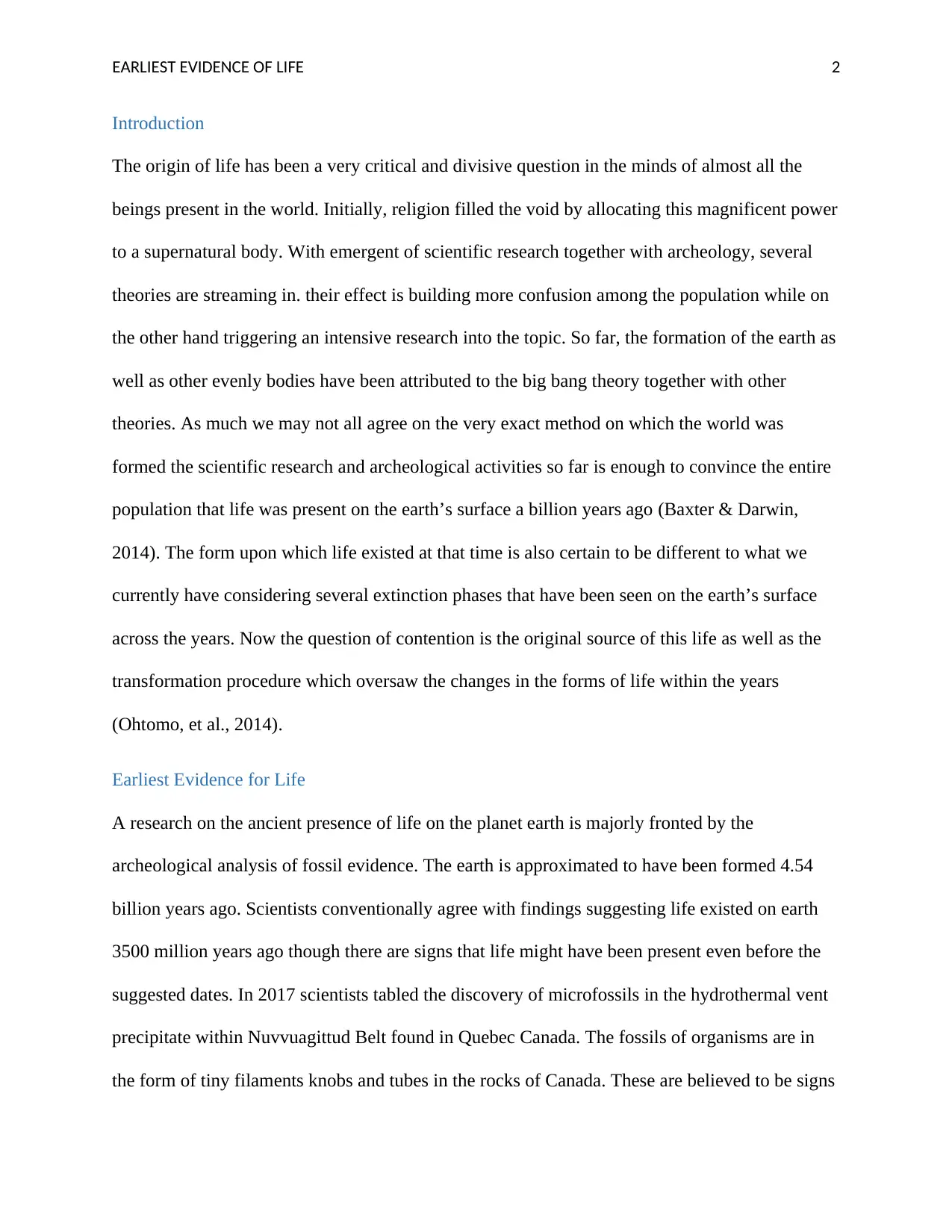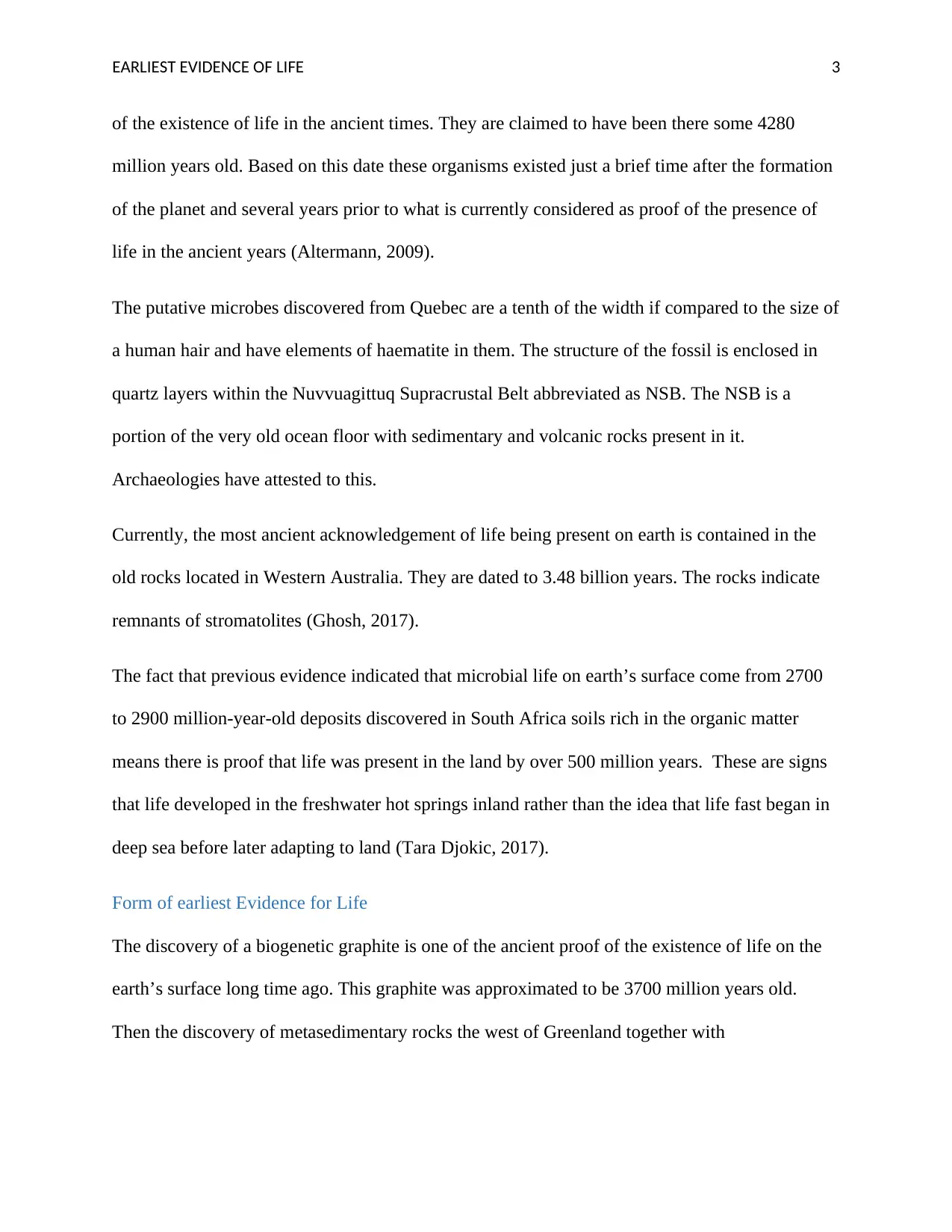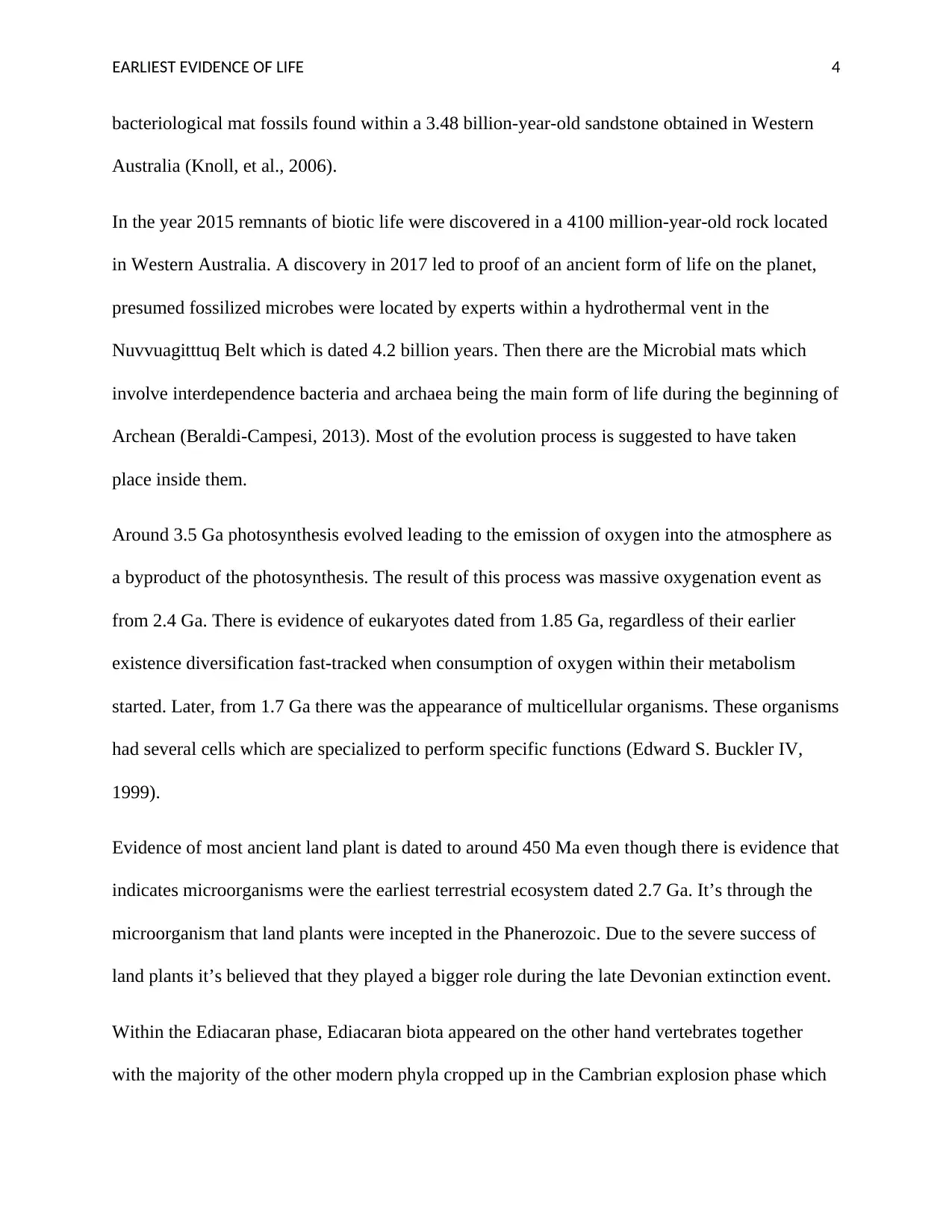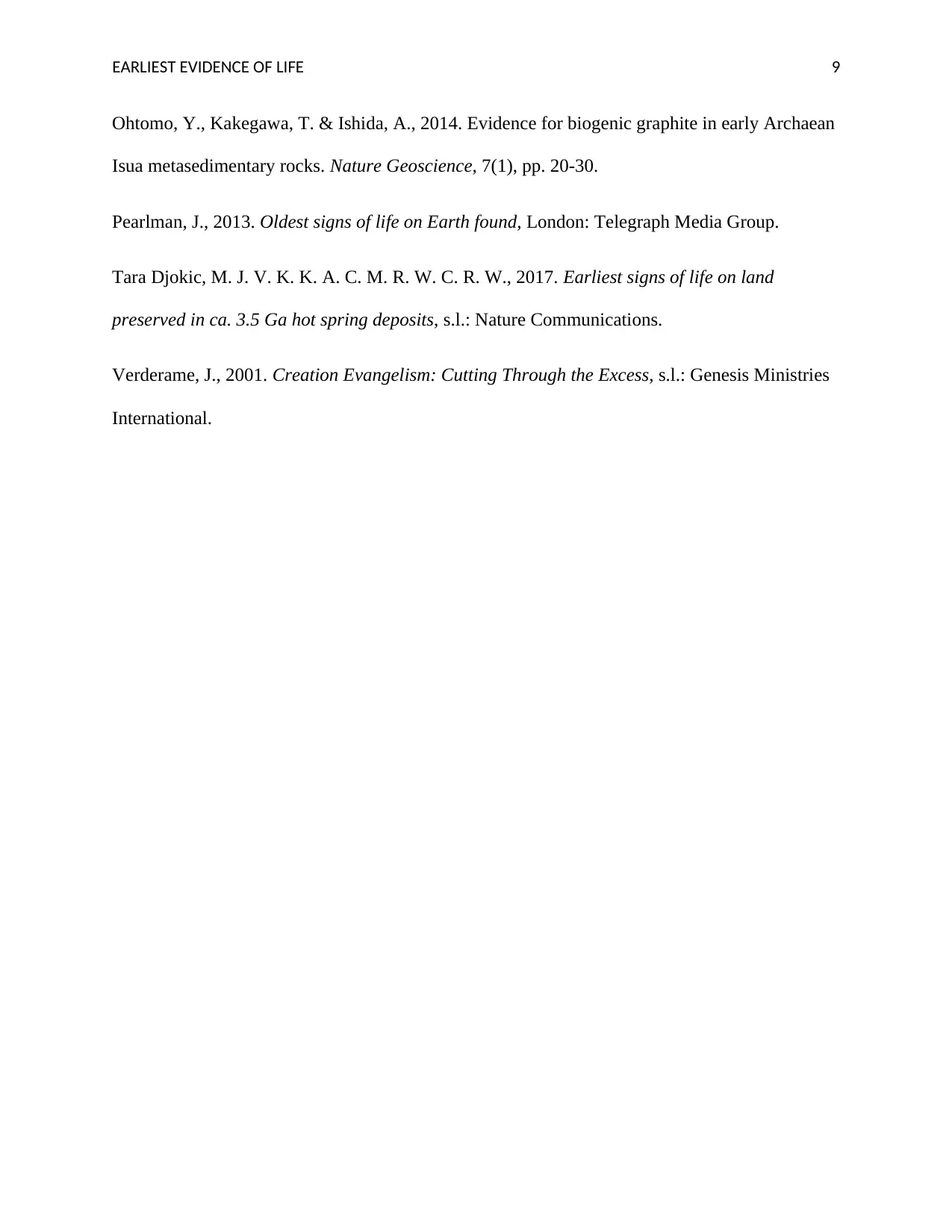Earliest Evidence of Life: Biological and Geological Perspectives
VerifiedAdded on 2020/04/01
|9
|2296
|220
Essay
AI Summary
This essay provides a comprehensive overview of the earliest evidence of life on Earth, examining the scientific and geological perspectives. It begins with an introduction to the controversies surrounding the origin of life and the role of scientific research and archeology. The essay then explores the earliest evidence, including the discovery of microfossils and stromatolites, and discusses the estimated timeline of life's emergence. It further delves into the forms of earliest life, such as biogenetic graphite and microbial mats, and the evolution of life from the Archean period to the Phanerozoic. The essay also addresses the controversies related to the earliest evidence of life, including debates over the Darwinian theory and the role of intelligent design. Finally, the essay concludes by summarizing the key findings and emphasizing the ongoing efforts to uncover more information about the origins of life. The essay is based on research from various scientific journals and publications. Desklib provides past papers and solved assignments for students.

EARLIEST EVIDENCE OF LIFE 1
Paraphrase This Document
Need a fresh take? Get an instant paraphrase of this document with our AI Paraphraser

EARLIEST EVIDENCE OF LIFE 2
Introduction
The origin of life has been a very critical and divisive question in the minds of almost all the
beings present in the world. Initially, religion filled the void by allocating this magnificent power
to a supernatural body. With emergent of scientific research together with archeology, several
theories are streaming in. their effect is building more confusion among the population while on
the other hand triggering an intensive research into the topic. So far, the formation of the earth as
well as other evenly bodies have been attributed to the big bang theory together with other
theories. As much we may not all agree on the very exact method on which the world was
formed the scientific research and archeological activities so far is enough to convince the entire
population that life was present on the earth’s surface a billion years ago (Baxter & Darwin,
2014). The form upon which life existed at that time is also certain to be different to what we
currently have considering several extinction phases that have been seen on the earth’s surface
across the years. Now the question of contention is the original source of this life as well as the
transformation procedure which oversaw the changes in the forms of life within the years
(Ohtomo, et al., 2014).
Earliest Evidence for Life
A research on the ancient presence of life on the planet earth is majorly fronted by the
archeological analysis of fossil evidence. The earth is approximated to have been formed 4.54
billion years ago. Scientists conventionally agree with findings suggesting life existed on earth
3500 million years ago though there are signs that life might have been present even before the
suggested dates. In 2017 scientists tabled the discovery of microfossils in the hydrothermal vent
precipitate within Nuvvuagittud Belt found in Quebec Canada. The fossils of organisms are in
the form of tiny filaments knobs and tubes in the rocks of Canada. These are believed to be signs
Introduction
The origin of life has been a very critical and divisive question in the minds of almost all the
beings present in the world. Initially, religion filled the void by allocating this magnificent power
to a supernatural body. With emergent of scientific research together with archeology, several
theories are streaming in. their effect is building more confusion among the population while on
the other hand triggering an intensive research into the topic. So far, the formation of the earth as
well as other evenly bodies have been attributed to the big bang theory together with other
theories. As much we may not all agree on the very exact method on which the world was
formed the scientific research and archeological activities so far is enough to convince the entire
population that life was present on the earth’s surface a billion years ago (Baxter & Darwin,
2014). The form upon which life existed at that time is also certain to be different to what we
currently have considering several extinction phases that have been seen on the earth’s surface
across the years. Now the question of contention is the original source of this life as well as the
transformation procedure which oversaw the changes in the forms of life within the years
(Ohtomo, et al., 2014).
Earliest Evidence for Life
A research on the ancient presence of life on the planet earth is majorly fronted by the
archeological analysis of fossil evidence. The earth is approximated to have been formed 4.54
billion years ago. Scientists conventionally agree with findings suggesting life existed on earth
3500 million years ago though there are signs that life might have been present even before the
suggested dates. In 2017 scientists tabled the discovery of microfossils in the hydrothermal vent
precipitate within Nuvvuagittud Belt found in Quebec Canada. The fossils of organisms are in
the form of tiny filaments knobs and tubes in the rocks of Canada. These are believed to be signs

EARLIEST EVIDENCE OF LIFE 3
of the existence of life in the ancient times. They are claimed to have been there some 4280
million years old. Based on this date these organisms existed just a brief time after the formation
of the planet and several years prior to what is currently considered as proof of the presence of
life in the ancient years (Altermann, 2009).
The putative microbes discovered from Quebec are a tenth of the width if compared to the size of
a human hair and have elements of haematite in them. The structure of the fossil is enclosed in
quartz layers within the Nuvvuagittuq Supracrustal Belt abbreviated as NSB. The NSB is a
portion of the very old ocean floor with sedimentary and volcanic rocks present in it.
Archaeologies have attested to this.
Currently, the most ancient acknowledgement of life being present on earth is contained in the
old rocks located in Western Australia. They are dated to 3.48 billion years. The rocks indicate
remnants of stromatolites (Ghosh, 2017).
The fact that previous evidence indicated that microbial life on earth’s surface come from 2700
to 2900 million-year-old deposits discovered in South Africa soils rich in the organic matter
means there is proof that life was present in the land by over 500 million years. These are signs
that life developed in the freshwater hot springs inland rather than the idea that life fast began in
deep sea before later adapting to land (Tara Djokic, 2017).
Form of earliest Evidence for Life
The discovery of a biogenetic graphite is one of the ancient proof of the existence of life on the
earth’s surface long time ago. This graphite was approximated to be 3700 million years old.
Then the discovery of metasedimentary rocks the west of Greenland together with
of the existence of life in the ancient times. They are claimed to have been there some 4280
million years old. Based on this date these organisms existed just a brief time after the formation
of the planet and several years prior to what is currently considered as proof of the presence of
life in the ancient years (Altermann, 2009).
The putative microbes discovered from Quebec are a tenth of the width if compared to the size of
a human hair and have elements of haematite in them. The structure of the fossil is enclosed in
quartz layers within the Nuvvuagittuq Supracrustal Belt abbreviated as NSB. The NSB is a
portion of the very old ocean floor with sedimentary and volcanic rocks present in it.
Archaeologies have attested to this.
Currently, the most ancient acknowledgement of life being present on earth is contained in the
old rocks located in Western Australia. They are dated to 3.48 billion years. The rocks indicate
remnants of stromatolites (Ghosh, 2017).
The fact that previous evidence indicated that microbial life on earth’s surface come from 2700
to 2900 million-year-old deposits discovered in South Africa soils rich in the organic matter
means there is proof that life was present in the land by over 500 million years. These are signs
that life developed in the freshwater hot springs inland rather than the idea that life fast began in
deep sea before later adapting to land (Tara Djokic, 2017).
Form of earliest Evidence for Life
The discovery of a biogenetic graphite is one of the ancient proof of the existence of life on the
earth’s surface long time ago. This graphite was approximated to be 3700 million years old.
Then the discovery of metasedimentary rocks the west of Greenland together with
⊘ This is a preview!⊘
Do you want full access?
Subscribe today to unlock all pages.

Trusted by 1+ million students worldwide

EARLIEST EVIDENCE OF LIFE 4
bacteriological mat fossils found within a 3.48 billion-year-old sandstone obtained in Western
Australia (Knoll, et al., 2006).
In the year 2015 remnants of biotic life were discovered in a 4100 million-year-old rock located
in Western Australia. A discovery in 2017 led to proof of an ancient form of life on the planet,
presumed fossilized microbes were located by experts within a hydrothermal vent in the
Nuvvuagitttuq Belt which is dated 4.2 billion years. Then there are the Microbial mats which
involve interdependence bacteria and archaea being the main form of life during the beginning of
Archean (Beraldi-Campesi, 2013). Most of the evolution process is suggested to have taken
place inside them.
Around 3.5 Ga photosynthesis evolved leading to the emission of oxygen into the atmosphere as
a byproduct of the photosynthesis. The result of this process was massive oxygenation event as
from 2.4 Ga. There is evidence of eukaryotes dated from 1.85 Ga, regardless of their earlier
existence diversification fast-tracked when consumption of oxygen within their metabolism
started. Later, from 1.7 Ga there was the appearance of multicellular organisms. These organisms
had several cells which are specialized to perform specific functions (Edward S. Buckler IV,
1999).
Evidence of most ancient land plant is dated to around 450 Ma even though there is evidence that
indicates microorganisms were the earliest terrestrial ecosystem dated 2.7 Ga. It’s through the
microorganism that land plants were incepted in the Phanerozoic. Due to the severe success of
land plants it’s believed that they played a bigger role during the late Devonian extinction event.
Within the Ediacaran phase, Ediacaran biota appeared on the other hand vertebrates together
with the majority of the other modern phyla cropped up in the Cambrian explosion phase which
bacteriological mat fossils found within a 3.48 billion-year-old sandstone obtained in Western
Australia (Knoll, et al., 2006).
In the year 2015 remnants of biotic life were discovered in a 4100 million-year-old rock located
in Western Australia. A discovery in 2017 led to proof of an ancient form of life on the planet,
presumed fossilized microbes were located by experts within a hydrothermal vent in the
Nuvvuagitttuq Belt which is dated 4.2 billion years. Then there are the Microbial mats which
involve interdependence bacteria and archaea being the main form of life during the beginning of
Archean (Beraldi-Campesi, 2013). Most of the evolution process is suggested to have taken
place inside them.
Around 3.5 Ga photosynthesis evolved leading to the emission of oxygen into the atmosphere as
a byproduct of the photosynthesis. The result of this process was massive oxygenation event as
from 2.4 Ga. There is evidence of eukaryotes dated from 1.85 Ga, regardless of their earlier
existence diversification fast-tracked when consumption of oxygen within their metabolism
started. Later, from 1.7 Ga there was the appearance of multicellular organisms. These organisms
had several cells which are specialized to perform specific functions (Edward S. Buckler IV,
1999).
Evidence of most ancient land plant is dated to around 450 Ma even though there is evidence that
indicates microorganisms were the earliest terrestrial ecosystem dated 2.7 Ga. It’s through the
microorganism that land plants were incepted in the Phanerozoic. Due to the severe success of
land plants it’s believed that they played a bigger role during the late Devonian extinction event.
Within the Ediacaran phase, Ediacaran biota appeared on the other hand vertebrates together
with the majority of the other modern phyla cropped up in the Cambrian explosion phase which
Paraphrase This Document
Need a fresh take? Get an instant paraphrase of this document with our AI Paraphraser

EARLIEST EVIDENCE OF LIFE 5
is dated 525 Ma. The Permian period synapsids a period which saw the dominance of mammals’
ancestors on the land only for a good percentage of the group to undergo extinction in the
Permian-Triassic extinction which occurred in 22Ma. As recovery from this was taking place the
archosaurs ended up being the dominant vertebrates on the earth’s surface while the dinosaurs
dominated the Jurassic and Cretaceous periods. The post-Cretaceous-Paleogene extinction event
in the 66Mawhich killed of the nation-variant dinosaurs’ mammals’ size and diversity increased
rapidly (Dalrymple, 2001).
Controversies Relating Earliest Evidence for Life
As scientists, religious leaders and archaeologists continue to clash over the actual origin of life
controversies have continued to mushroom as each group tries to portray its side as the ultimate
answer to the question where did we come from? (Flank, 2006)
To begin several scientists do not approve of the notion that a single ancestor is a root to the
evolvement of all the organisms. This is because in the study of fossils a biological big bang is
said to have taken place as we neared the beginning of the Cambrian phase. Here many distinct
groups of organisms, as well as animal body parts, emerged suddenly with no precursors. The
fossil findings stress on an outline of explosive appearance and a lengthy living forms stability
which is not in line with the gradual system of the evolution of life as spearheaded by Darwin’s
popular ancestry theory. This stand is further supported by scientific discoveries in molecular
genetics and embryology.
A section of scientists does not believe in the creative power of the Darwinian mechanism. Even
though majority agree that through natural selection small-scale microevolutionary can be
attained several them are questioning the ability of natural selection and random mutation to
produce the massive changes which are needed to end up with new structures and forms of life
is dated 525 Ma. The Permian period synapsids a period which saw the dominance of mammals’
ancestors on the land only for a good percentage of the group to undergo extinction in the
Permian-Triassic extinction which occurred in 22Ma. As recovery from this was taking place the
archosaurs ended up being the dominant vertebrates on the earth’s surface while the dinosaurs
dominated the Jurassic and Cretaceous periods. The post-Cretaceous-Paleogene extinction event
in the 66Mawhich killed of the nation-variant dinosaurs’ mammals’ size and diversity increased
rapidly (Dalrymple, 2001).
Controversies Relating Earliest Evidence for Life
As scientists, religious leaders and archaeologists continue to clash over the actual origin of life
controversies have continued to mushroom as each group tries to portray its side as the ultimate
answer to the question where did we come from? (Flank, 2006)
To begin several scientists do not approve of the notion that a single ancestor is a root to the
evolvement of all the organisms. This is because in the study of fossils a biological big bang is
said to have taken place as we neared the beginning of the Cambrian phase. Here many distinct
groups of organisms, as well as animal body parts, emerged suddenly with no precursors. The
fossil findings stress on an outline of explosive appearance and a lengthy living forms stability
which is not in line with the gradual system of the evolution of life as spearheaded by Darwin’s
popular ancestry theory. This stand is further supported by scientific discoveries in molecular
genetics and embryology.
A section of scientists does not believe in the creative power of the Darwinian mechanism. Even
though majority agree that through natural selection small-scale microevolutionary can be
attained several them are questioning the ability of natural selection and random mutation to
produce the massive changes which are needed to end up with new structures and forms of life

EARLIEST EVIDENCE OF LIFE 6
altogether. This has made the issue of selection and mutation mechanism to be a controversial
topic in the evolution of life (Larson, 2004).
As scientists continue to put more effort in researching on early forms of life doubts are
emerging regarding the Darwinian Theory stating that life just appears in their design. Instead,
they are stressing the fact that there is a display of signs of actual intelligent among the living
organisms. The existence of digital information, complex circuits as well as miniature motors
within the living cells have been used by professional scientists to argue in support of this case.
There is a long history of controversy between science and religion when it comes to the origin
of life. With the Christians, the question of the origin of life is illustrated in the book of Genesis
where a supernatural being is accorded the sole power the give or take life in all forms. While
scientists are for the genetic evolution and archeologist’s analysis fossils to prove their own
theories, they seem to be no agreement between the groups of which are the facts regarding the
origin of life (Lewin, 1982).
Conclusion
What’s the origin of life? There no question bigger than this. Man, despite having the biblical
version of God created life and the controversies there after having gone ahead to dig into
scientific research and archeology to research on their own theories. So far archaeologists have
obtained fossils which are around 3.5 billion years old a number which is 14 times the age of the
oldest dinosaur ever present on land. The age of the fossils is still stretching back with the
advancing research. The recent discovery of microbes dating back to 3.7 billion years is a sign.
The earth is predicted to have formed 4.5 billion years ago because life has not been able to be
discovered anywhere else apart from the earth then there is a probability that life formed between
the time the earth was formed and the age of the oldest fossil (Verderame, 2001).
altogether. This has made the issue of selection and mutation mechanism to be a controversial
topic in the evolution of life (Larson, 2004).
As scientists continue to put more effort in researching on early forms of life doubts are
emerging regarding the Darwinian Theory stating that life just appears in their design. Instead,
they are stressing the fact that there is a display of signs of actual intelligent among the living
organisms. The existence of digital information, complex circuits as well as miniature motors
within the living cells have been used by professional scientists to argue in support of this case.
There is a long history of controversy between science and religion when it comes to the origin
of life. With the Christians, the question of the origin of life is illustrated in the book of Genesis
where a supernatural being is accorded the sole power the give or take life in all forms. While
scientists are for the genetic evolution and archeologist’s analysis fossils to prove their own
theories, they seem to be no agreement between the groups of which are the facts regarding the
origin of life (Lewin, 1982).
Conclusion
What’s the origin of life? There no question bigger than this. Man, despite having the biblical
version of God created life and the controversies there after having gone ahead to dig into
scientific research and archeology to research on their own theories. So far archaeologists have
obtained fossils which are around 3.5 billion years old a number which is 14 times the age of the
oldest dinosaur ever present on land. The age of the fossils is still stretching back with the
advancing research. The recent discovery of microbes dating back to 3.7 billion years is a sign.
The earth is predicted to have formed 4.5 billion years ago because life has not been able to be
discovered anywhere else apart from the earth then there is a probability that life formed between
the time the earth was formed and the age of the oldest fossil (Verderame, 2001).
⊘ This is a preview!⊘
Do you want full access?
Subscribe today to unlock all pages.

Trusted by 1+ million students worldwide

EARLIEST EVIDENCE OF LIFE 7
The development of the microscope contributed a lot in the study of life. This proved that as
much as organisms differ in shapes and appearance they are made up of cells which look alike
for the case of animals and in the case of plants. The study of the way the earth formed together
with the theory of the origin of life as a single cell from a chemical reaction is now being
massively supported by the idea of cells. For now, we only gauze the age of life but as more
effort is continuously being put into the matter we can only be hopeful that enough information
will be collected to back whichever theory that is solid enough to help mankind find an answer
their biggest question (Pearlman, 2013).
The development of the microscope contributed a lot in the study of life. This proved that as
much as organisms differ in shapes and appearance they are made up of cells which look alike
for the case of animals and in the case of plants. The study of the way the earth formed together
with the theory of the origin of life as a single cell from a chemical reaction is now being
massively supported by the idea of cells. For now, we only gauze the age of life but as more
effort is continuously being put into the matter we can only be hopeful that enough information
will be collected to back whichever theory that is solid enough to help mankind find an answer
their biggest question (Pearlman, 2013).
Paraphrase This Document
Need a fresh take? Get an instant paraphrase of this document with our AI Paraphraser

EARLIEST EVIDENCE OF LIFE 8
References
Altermann, W., 2009. From Fossils to Astrobiology – A Roadmap to Fata Morgana?, London:
s.n.
Baxter, C. & Darwin, 2014. Correspondence Project (research collaborator). "Re: Design".
Darwin Correspondence Project (Dramatisation script), England: University of Cambridge.
Beraldi-Campesi, H., 2013. Early life on land and the first terrestrial ecosystems. Ecological
Processes, 2(1), p. 4.
Dalrymple, G. B., 2001. The age of the Earth in the twentieth century: a problem (mostly)
solved. Geological Society Special Publication., Volume 190, p. 20–211. .
Edward S. Buckler IV, T. L. P.-D. C. S. K. B. R. K. D. J. F. D. a. T. P. H., 1999. Meiotic Drive
of Chromosomal Knobs Reshaped the Maize Genome. Genetics, 153 (1), p. 405–423.
Flank, L., 2006. The History of Creationism, Houston: The TalkOrigins Foundation.
Ghosh, P., 2017. BBC NEWS; Earliest evidence of life on Earth 'found'. [Online]
Available at: http://www.bbc.com/news/science-environment-39117523
[Accessed 19 September 2017].
Knoll, A. H., Javaux, E. J., Hewitt, D. & Cohen, P., 2006. Eukaryotic organisms in Proterozoic
oceans, s.l.: Philosophical Transactions of the Royal Society B.
Larson, 2004. "Virtually no secular scientists accepted the doctrines of creation science; but that
did not deter creation scientists from advancing scientific arguments for their position, s.l.: s.n.
Lewin, R., 1982. Where Is the Science in Creation Science?". Science. Washington, D.C.:.
American Association for the Advancement of Science., Volume 142, pp. 134, 146.
References
Altermann, W., 2009. From Fossils to Astrobiology – A Roadmap to Fata Morgana?, London:
s.n.
Baxter, C. & Darwin, 2014. Correspondence Project (research collaborator). "Re: Design".
Darwin Correspondence Project (Dramatisation script), England: University of Cambridge.
Beraldi-Campesi, H., 2013. Early life on land and the first terrestrial ecosystems. Ecological
Processes, 2(1), p. 4.
Dalrymple, G. B., 2001. The age of the Earth in the twentieth century: a problem (mostly)
solved. Geological Society Special Publication., Volume 190, p. 20–211. .
Edward S. Buckler IV, T. L. P.-D. C. S. K. B. R. K. D. J. F. D. a. T. P. H., 1999. Meiotic Drive
of Chromosomal Knobs Reshaped the Maize Genome. Genetics, 153 (1), p. 405–423.
Flank, L., 2006. The History of Creationism, Houston: The TalkOrigins Foundation.
Ghosh, P., 2017. BBC NEWS; Earliest evidence of life on Earth 'found'. [Online]
Available at: http://www.bbc.com/news/science-environment-39117523
[Accessed 19 September 2017].
Knoll, A. H., Javaux, E. J., Hewitt, D. & Cohen, P., 2006. Eukaryotic organisms in Proterozoic
oceans, s.l.: Philosophical Transactions of the Royal Society B.
Larson, 2004. "Virtually no secular scientists accepted the doctrines of creation science; but that
did not deter creation scientists from advancing scientific arguments for their position, s.l.: s.n.
Lewin, R., 1982. Where Is the Science in Creation Science?". Science. Washington, D.C.:.
American Association for the Advancement of Science., Volume 142, pp. 134, 146.

EARLIEST EVIDENCE OF LIFE 9
Ohtomo, Y., Kakegawa, T. & Ishida, A., 2014. Evidence for biogenic graphite in early Archaean
Isua metasedimentary rocks. Nature Geoscience, 7(1), pp. 20-30.
Pearlman, J., 2013. Oldest signs of life on Earth found, London: Telegraph Media Group.
Tara Djokic, M. J. V. K. K. A. C. M. R. W. C. R. W., 2017. Earliest signs of life on land
preserved in ca. 3.5 Ga hot spring deposits, s.l.: Nature Communications.
Verderame, J., 2001. Creation Evangelism: Cutting Through the Excess, s.l.: Genesis Ministries
International.
Ohtomo, Y., Kakegawa, T. & Ishida, A., 2014. Evidence for biogenic graphite in early Archaean
Isua metasedimentary rocks. Nature Geoscience, 7(1), pp. 20-30.
Pearlman, J., 2013. Oldest signs of life on Earth found, London: Telegraph Media Group.
Tara Djokic, M. J. V. K. K. A. C. M. R. W. C. R. W., 2017. Earliest signs of life on land
preserved in ca. 3.5 Ga hot spring deposits, s.l.: Nature Communications.
Verderame, J., 2001. Creation Evangelism: Cutting Through the Excess, s.l.: Genesis Ministries
International.
⊘ This is a preview!⊘
Do you want full access?
Subscribe today to unlock all pages.

Trusted by 1+ million students worldwide
1 out of 9
Related Documents
Your All-in-One AI-Powered Toolkit for Academic Success.
+13062052269
info@desklib.com
Available 24*7 on WhatsApp / Email
![[object Object]](/_next/static/media/star-bottom.7253800d.svg)
Unlock your academic potential
Copyright © 2020–2025 A2Z Services. All Rights Reserved. Developed and managed by ZUCOL.





